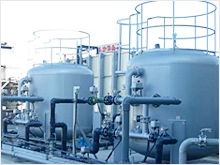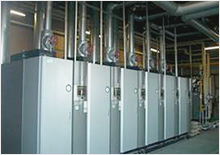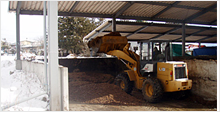One of Hanamaruki’s primary responsibilities is to operate in harmony with the global environment. Realizing that preserving the environment is a key issue for corporations, in 2009 we set up an Energy Conservation Committee in order to minimize our environmental impact
Managing Water
 Managing Well Water
Managing Well Water
In 2009 a filtration device was placed in the well water at the Otone Plant. In addition, we hold water inspections four times a year at both of our plants, including analyses of a range of 50 points in order to fulfill the tap water standards stipulated by external bodies.
 Managing Wastewater
Managing Wastewater
Hanamaruki was an early adopter of purifiers using a yeast and active sludge process to treat plant wastewater, returning it as far as possible back to its original state and taking all available steps not to harm the local natural environment.
Reducing CO2 Emissions
 Introduction of co-generation systems
Introduction of co-generation systems
Our main plant at Otone introduced a co-generation system in June 2012, for the purposes of generating electricity inside the company.
Having already changed fuel sources (from fuel oil to natural gas), this system secures 41% of the maximum power required for plant operation while also making effective use of the heat produced by the process.
Promoting fuel conversion
 We are also working to change to use of town gas and liquefied natural gas (LNG), which create less CO2 emissions when compared to fuel oil and contain virtually no sulfur oxides (SOX). In 2008 we converted our primary plant in Otone from fuel oil to town gas. In 2012 we converted our Ina Plant to LNG.
We are also working to change to use of town gas and liquefied natural gas (LNG), which create less CO2 emissions when compared to fuel oil and contain virtually no sulfur oxides (SOX). In 2008 we converted our primary plant in Otone from fuel oil to town gas. In 2012 we converted our Ina Plant to LNG.
Reusing byproducts and waste materials
 Turning wastewater sludge into fertilizer
Turning wastewater sludge into fertilizer
At our Ina Plant, wastewater from the miso production process is treated by a dehydrator, taken to farms and, after repeated drying and churning, fermented for use as fertilizer. The Otone Plant is also searching for farms to help use this material as fertilizer.
 Reduction and recycling of waste materials
Reduction and recycling of waste materials
The production process gives rise to a variety of byproducts and waste materials, including plant residues from soybeans and rice, sludge, waste wood and waste paper.
Hanamaruki is involved with the recycling of these byproducts and waste materials by finding ways to reuse them.
In regard to appropriate management of waste materials, we aim for compliance with the manifest system of industrial waste and uniform control of waste material information.
